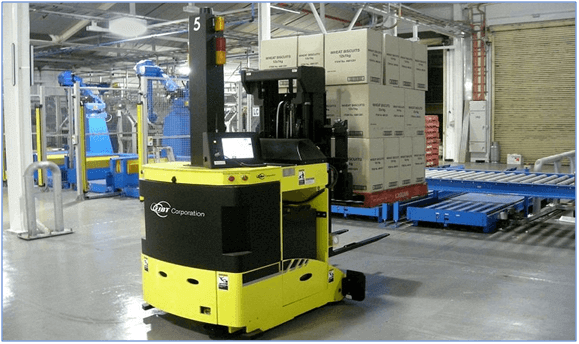It has been a while since we first heard about autonomous vehicles, autonomous robots and drones, which have an enormous potential to disrupt the supply chain industry. These technologies that once seemed a distant future, now become a reality. The implementation of driverless technologies in the supply chain has already started. According to the 2017 MHI Annual Industry Report, 8% of the survey respondents are already using driverless vehicles and drone technologies and about 30% are planning to adopt them in 1-5 years.
Table of Contents
Autonomous Vehicles Technology
This technology once implemented, provides enormous benefits, from Unmanned Aerial or Ground Vehicles, humanoid machine and driverless forklifts to mobile robots, there are several machines on the market using autonomous transport and robots in warehouses, distribution centres and manufacturing facilities. Driverless vehicles and robots are now being used for moving products in a warehouse, order pick and pack operations and inventory control. For example, autonomous robots can bring products to human pickers at a work station instead of the traditional way when employees move around a warehouse. Unloading and put away process can also become fully automated soon can now move about the warehouse without human control, as shown in the picture below.

Autonomous Vehicles in the Warehousing
The Autonomous Mobile Robot market is expected to register a Compound Annual Growth Rate (CAGR) of over 14% during the forecast period (2018 – 2023). The modern supply chain is witnessing warehouse automation in the form of various autonomous driving vehicles like automated stackers, forklifts, pallet trucks, and small rack carrying robots like Kiva and Fetch. Although not widely adopted, AGVs (Autonomous Guided Vehicles) promise to revolutionize the way cargo is transported inside and outside the warehouse. They are the very potential substitutes of the forklift inside the warehouse. The picture below shows the autonomous Guided Vehicles (AGVs) operating in a warehouse.

There have already been some experiments most warehousing are looking to these machines to reduce waste and human movement, the average warehouse worker wastes nearly seven weeks per year in unnecessary motion, accounting for more than $4.3 billion in labor. But the benefits extend well beyond labour savings. Mobile robotics can also reduce workers’ compensation and your safety issues within a facility by separating human traffic from large vehicle traffic.
There are three type of essential frameworks for Autonomous Vehicles, as follows:
1. TheHype Cycle
Autonomous Vehicles on the after-peak phase of the Peak of Inflated Expectations on the 2017 Hype Cycle for Emerging Technologies. It means that the hype about the technology is on the verge of dying. That it is expected to reach the Plateau of Productivity in more than 10 years, implying that you may still have some time to explore the viability of adopting autonomous vehicles in the warehouse.
2. The Innovation Adoption Life Cycle
With an increasing number of warehouses and distribution centres adopting this technology, we find it safe to say that AGVs are crossing the Chasm with Early Adopters on their side. There will be mass adoption in the coming years. Automated guided vehicle manufacturers like Swisslog, Fetch Robotics, JBT, Savant, etc., are making constant innovation to add value to these enablers, making material handling more efficient, productive, and safe.
3. S Curve of Innovation Diffusion
Automated Guided Vehicles are becoming integral parts of warehouses and distributions centres as they cross into the Take off Stage on the s-curve of innovation diffusion. Growth and innovation are consistent, with expectation of more growth for a few years to come.
Importance of Artificial Intelligence (AI) in Logistics
AI is being extensively called upon to enhance the self-learning capabilities of Autonomous Vehicles. Many more examples evidence AI’s benefits with the ability to transform the world of the industry after its transformational impact on the consumer world. Clearly, AI augments human capabilities but also eliminates routine work, which will shift the focus of logistics workforces to more meaningful and value-added work. Technology is changing the logistics industry’s traditional value chains, and ecosystems are reshaping enterprises, industries, and economies.

Real-time Data Gathering and Increased Interconnectivity
• Cloud Storage has revolutionised many industries and logistics is no different. By implementing self-updating and hosted computer systems, cloud storage offers many benefits to warehousing include cutting down on maintenance, infrastructure and labour costs that come from the installation and upgrading of warehouse management systems.
The full content is only visible to SIPMM members
Already a member? Please Login to continue reading.
References
Bern Grush & John Niles.(2018). Retrieved from http://endofdriving.org/wp-content/uploads/2016/02/What-Gartner%E2%80%99s-Technology-Hype-Cycle-teaches-us-about-the-autonomous-vehicle.pdf, accessed 02/08/2018.
Chua Yue Xuan. (2018). “Autonomous Vehicles for Effective Supply Chain”. Retrieved from SIPMM: https://publication.sipmm.edu.sg/autonomous-vehicles-effective-supply-chain, accessed 02/08/2018.
Hector. (2018). “Autonomous Vehicles in Warehouse Management”. Retrieved from https://articles.cyzerg.com/autonomous-vehicles-in-warehouse-management-is-it-time-yet, accessed 02/08/2018.
Leslie Sullivan. (2017). “Top 10 Features of Autonomous Warehouse”. Retreived from https://www.evansdist.com/top-10-features-autonomous-warehouse, accessed 02/08/2018.
Mordor.(2018). “Autonomous Mobile Robot Market”. Retrieved from https://www.mordorintelligence.com/industry-reports/autonomous-mobile-robot-market, accessed 02/08/2018.

